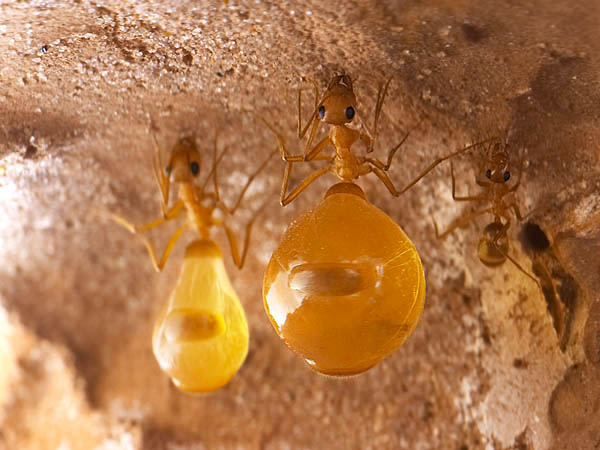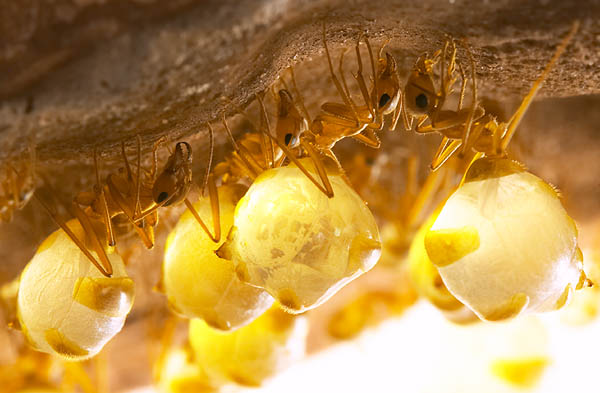Adaptation
Swollen and semi-swollen repletes hanging from chamber wall. Photo by Alex Wild.
Myrmecocystus mexicanus
are unusual in the manner that they can produce workers with swollen
abdomens called repletes that have the ability to store the seasonal flow of
nectar, lipid solutions, and water. The coloring on the swollen abdomen on
the repletes may vary due to the differences in the nectar solution, but
they usually appear to be gold in color. (Rissing, 1984; Conway, 1990).
These individual repletes become so large they walk with great difficulty,
if they are able to walk at all. When fully engorged, repletes are unable to
walk and are therefore lost from the worker force. Other worker ants are
able to continue supplying the repletes with more food for storage by
foraging it and then regurgitating it when they return to the nest (Duncan
and
Lighton, 1994). The average replete, at 0.64 grams, is 299 times heavier
than the average worker (Conway, 1990). M. mexicanus ability to store
these solutions is vital as it is what accounts for their survival in very
dry environments. When nutrients are scarce, the colony is able to survive
from the storage in the repletes (Rissing, 1984).
Swollen repletes hanging from chamber wall. Photo by Alex Wild.
It is obvious that repletes are vital to a colonies survival, but what
causes workers to be selected to become repletes in the first place? In a
study done on an
M. mexicanus
colony, it was found that when the first set of repletes was removed from
the colony, the largest remaining ants in the colony would then became
repletes. This study also showed that the second set of repletes were
significantly smaller than the first (Rissing, 1984). It is important that
the largest ants in the colony become repletes. The less ants lost from the
work force, the more ants remain to protect and fend for the colony. The
largest repletes will minimize the number of ants lost from the work force.
Along with the creation of repletes,
M. mexicanus
have other means that help them survive in their harsh
habitat. The nests of
M. mexicanus are located underground and contain many chambers. The
depth of the chambers vary depending on the environment. The nests
containing deeper chambers are created a result of higher temperatures in
the outside environment. These chambers are able to better protect the
repletes and other workers from dehydration (Conway, 1990). Another positive
effect of the ants creating these deep chambers is that predation on the
colonies is low. This is a result of the chambers making
interactions with other species difficult
because they can be hard to find and enter. There have been cases of beetles and crickets
being found in excavated chambers, as well as nests being
unearthed by badgers, and dead workers being carried off by spiders (Conway,
1990). However, overall the underground nests have the ability to offer
better protection to the colonies than a nest above the ground would.
This page was created by Elisabeth Kujala

